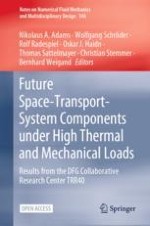Turbulent flow and combustion processes are described by the compressible Navier-Stokes equations that, in addition, include equations for turbulence modeling and species transport. The set of governing equations is given by
$$\begin{aligned} \frac{\partial \mathbf {Q}}{\partial t} +\frac{\partial \left( \mathbf {F}-\mathbf {F}_v \right) }{\partial x}+\frac{\partial \left( \mathbf {G}-\mathbf {G}_v \right) }{\partial y}+\frac{\partial \left( \mathbf {H}-\mathbf {H}_v \right) }{\partial z}=\mathbf {S} \end{aligned}$$
(1)
with
$$\begin{aligned} \mathbf {Q}=\left[ \rho ,\rho u,\rho v,\rho w,\rho E,\rho k,\rho \omega ,\rho \sigma _T,\rho \sigma _Y,\rho Y_i \right] ^\top ,\, i=1,\dots ,N_k-1\;. \end{aligned}$$
(2)
Here,
\( \mathbf {Q} \) denotes the vector of conservative quantities consisting of the density
\( \rho \), the velocities
u,
v,
w in each direction, the total specific energy
E, the turbulence quantities
k and
\( \omega \), the temperature variance
\(\sigma _T\), the sum of the variances of all species mass fractions
\(\sigma _Y\) as well as the
\( N_k-1 \) independent species mass fractions
\( Y_i \).
\( N_k \) is the number of considered species.
\( \mathbf {F} \),
\(\mathbf {G}\) and
\(\mathbf {H}\) indicate the inviscid fluxes in
x-,
y- and
z-direction, respectively.
\( \mathbf {F}_v \),
\(\mathbf {G}_v\) and
\(\mathbf {H}_v\) are the corresponding viscous fluxes. The source vector
$$\begin{aligned} \mathbf {S}=\left[ 0,0,0,0,0,S_k,S_\omega ,S_{\sigma _T},S_{\sigma _Y},S_{Y_i}\right] ^\top ,\, i=1,\dots ,N_k-1 \end{aligned}$$
(3)
includes terms resulting from turbulence and chemistry. The species source terms
$$\begin{aligned} S_{Y_i}=M_i \sum _{r=1}^{N_r} \left[ \left( \nu _{i,r}^{\prime \prime } - \nu _{i,r}^\prime \right) \left( k_{f_r} \prod _{l=1}^{N_k+1} c_l^{\nu _{l,r}^\prime } - k_{b_r} \prod _{l=1}^{N_k+1} c_l^{\nu _{l,r}^{\prime \prime }}\right) \right] \end{aligned}$$
(4)
include
\(k_{f_r}\) and
\(k_{b_r}\) which denote the forward and backward reaction rates of reaction
r. Furthermore,
\(\nu _{i,r}^{\prime }\) and
\(\nu _{i,r}^{\prime \prime } \) represent the stoichiometric coefficients of species
i for the forward and backward reaction, respectively.
\(N_r\) stands for the number of reactions,
\(M_i\) is the molar mass of the specified species, and
\( c_l \) the concentration of species
l. A virtual species
\(N_k+1\) is introduced to account for three-body reactions.
To close this set of equations, an equation of state is required. This is either the ideal gas law or, for real gas effects, the Soave–Redlich–Kwong (SRK) equation.
